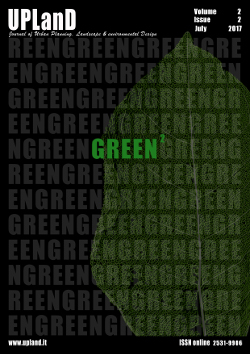The suitability of sustainable retrofitting means for shopping malls, in an environmental and urban background. A resume of the methodology
Main Article Content
Abstract
The current paper shows the resume of a methodology of application, developed in the paper´s author PHD thesis, showing an overview of the methodology structure, being also included the first results of the case study. The research was focused on the analysis of different means of sustainable retrofitting applied to shopping malls buildings, considering both features of urban background and building conditions (eco efficiency of building, nature and environment capabilities, uses, and current state of the urban surroundings towards urban eco efficiency). Eight cases of study were chosen, placed in different areas in the cities of Sao Paulo, Madrid, and suburban USA. According to the methodology established, the results achieved show that the means of retrofitting for the shopping malls studied, must be aimed to insert green regenerative elements in the background of the dense and complex urban areas of Sao Paulo and Madrid. As contrast to this, in the Suburban USA, retrofitting operations must be focused on the densification and insertion of uses complexity within the urban surroundings.
Downloads
Article Details

This work is licensed under a Creative Commons Attribution-NonCommercial-NoDerivatives 4.0 International License.
Authors who publish with this journal agree to the following terms:- Authors retain copyright and grant the journal right of first publication with the work simultaneously licensed under a Creative Commons Attribution License that allows others to share the work with an acknowledgement of the work's authorship and initial publication in this journal.
- Authors are able to enter into separate, additional contractual arrangements for the non-exclusive distribution of the journal's published version of the work (e.g., post it to an institutional repository or publish it in a book), with an acknowledgement of its initial publication in this journal.
- Authors are permitted and encouraged to post their work online (e.g., in institutional repositories or on their website) prior to and during the submission process, as it can lead to productive exchanges, as well as earlier and greater citation of published work (See The Effect of Open Access).
References
Abrudan I. Et al. (2009). The Life Cycle Of Shopping Centers And Possible Revitalization Strategies. Oradea, RO: Facultatea de Stiinte Economice, Faculty of Economic Sciences.
Ainsworth, J., & Foster, J. (2017). Comfort in brick and mortar shopping experiences: Examining antecedents and consequences of comfortable retail experiences. Journal of Retailing and Consumer Services, 35, 27-35.
Bruntland, G. H. (1987). Our Common Future. New York, US: United Nations.
Cárdenas, L. & Higueras, E. (2015). El Barrio Solar. Madrid, ES: Mairea Libros, Polytechnic University of Madrid.
Chebat, J. C., Michon, R., Haj-Salem, N., & Oliveira, S. (2014). The effects of mall renovation on shopping values, satisfaction and spending behaviour. Journal of retailing and consumer services, 21(4), 610-618.
Chistina, A. (2010). Adensamento e forma Urbana: Inserção de Parâmetros Ambientais no Processo de Projeto. São Paulo, Universidade de São Paulo.
Congress for the new urbanism (2005). Malls Into Mainstreets. Published in the webpage of the Congress For the New Urbanism. https://www.cnu.org/sites/files/mallsintomainstreets.pdf
Del Río Roger, & Sánchez (2013). Impacto Medioambiental de los Centros Comerciales: de Gran Vía a Xanadú. Madrid, ES: Mercasa.
Dunham-Jones, E., & Williamson, J. (2011). Retrofitting Suburbia, Urban Solutions For Redesigning Suburbs. Hobokey, New Jersey, US: John Willey and Sons.
Ewerton, R. (2011). Shopping Centers e Condomínios Fechados: Fragmentação, Homogeneização e Hierarquização na Cidade Contemporânea, Published in the Page Urbanidades. http://urbanidades.arq.br/2011/09/shopping-centers-e-condominios-fechados-fragmentacao-homogeneizacao-e-hierarquizacao-na-cidade-contemporanea/
Filion, P., & Hammond, K. (2006). The failure of shopping malls as a tool of downtown revitalization in mid-size urban areas. Plan Canada, 46(4), 49-52.
Gruen, V. (1973). Centers for the Urban Developement. New York, US: Van Nostrand Reinhold Company, Victor Gruen Foundation for the environmental planning, Lilton Educational Publishing.
Higueras, E., & Neila, J. (2012). Urbanismo Solar, manual de buenas prácticas para Vitoria Gastéiz. Vitoria, ES: Council of Vitoria Gasteiz, Polytechnic University of Madrid.
Hughes, G. (1999). Urban revitalization: The use of festive time strategies. Leisure studies, 18(2), 119-135.
Khayyambashi, P., & Ghobadian, V. (2014). Shopping mall design based on the placemaking and sustainability factors. Journal of current research in science, 2(1), 162-167.
Koolhas R. et al. (2000). Mutaciones. Barcelona ES, FR: Actar.
Losasso, M. (2016). Climate risk, Environmental planning, Urban design. UPLanD – Journal of Urban Planning, Landscape & environmental Design, 1(1), 219-232.
Maraschin, C. et al.. (2010). Shopping Centers e Seu Entorno Inmediato. Rio de Janeiro, BR: ENANPARQ, Primeiro encontro da Associaçao Nacional de Pesquisa e Pos Graduaçao en Arquitetura e urbanismo.
Moccia, F.D. & Sgobbo, A. (2013). La polarizzazione metropolitana. L'evoluzione della rete della grande distribuzione verso un sistema policentrico sostenibile. Napoli, IT: Liguori.
Naredo J. M. (1997). Sobre el Origen, el uso y el contenido del término Sostenible. Madrid, ES: Politechnical University of Madrid, "Biblioteca Ciudades Para un Futuro Más Sostenible".
Oficina Ecosistema Urbano: (June 2015). Reinventarse o Morir, la Transformación de los Centros Comerciales bajo el Nuevo Paradigma Económico/Urbano. Retrieved from http://www.plataformaarquitectura.cl
Oslo Center for Urban and Landcape Studies. (2014). Rethinking Retail – A Case for Courtyard Shopping. Retrieved from http://www.oculs.no/news/rethinking-retail-case-courtyard-shopping/
Padilha, V. (2012), Shopping Center a Catedral das Mercadorias. São Paulo, BR: Boitempo,
Richard, A. F., & Jennifer M. (1991). A Brief History of the Mall, United States. In Rebecca H. Holman and Michael R. Solomon. Provo (eds.), Advances in Consumer Research Volumen 18 (pp: 426-427). US: Association for Consumer Research.
Rueda, S. (1999). Modelos E Indicadores Para Ciudades Mas Sostenibles. Rubí, Barcelona, ES: Departament de Medi Ambient de la Generalitat de Catalunya, Fundació Fórum Ambiental.
Sena, İ et al (2010). Negative Effects of Shopping Malls. Faculty of Architecture.
Sgobbo, A. (2016). Recycling, waste management and urban vegetable gardens. WIT Transactions on Ecology and The Environment, 202, 61-72. doi:10.2495/WM160071
Sugrue, T. J. (2014). The origins of the urban crisis: Race and inequality in postwar Detroit. Princeton, US: Princeton University Press.
Wakefield, K. L., & Baker, J. (1998). Excitement at the mall: determinants and effects on shopping response. Journal of retailing, 74(4), 515-539.

